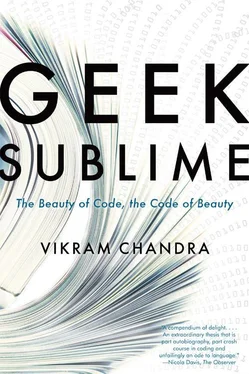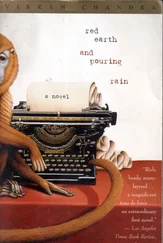This generalization, this trans-personalization, sadharanikarana , is the essential basis of the aesthetic experience. The framing of an object as art produces this necessary detachment from the limited ego. For a viewer, “the tasting of pleasures, pains, etc., inhering in his own [limited] person” prevents the relishing of rasa. 3 The attachment to limited self prevents universalization; if you are grieving over your own long-lost mother, you are not relishing the rasa of the tragic death scene in the movie you are watching.
The means of eliminating this obstacle are the so called theatrical conventions ( nāṭyadharmi ), which include a number of things not found in ordinary life, as, for instance, the zones ( kakṣyā ) dividing the pavilion ( maṇḍapa ), the stage ( raṇgapīṭha ); and … also the different dress of the actors — the headwear, etc. — by which they hide their true identity. 4
It is the very artificiality and conventionality of the aesthetic experience, therefore, that makes the unique experience of rasa possible. Abhinavagupta observes:
In the theatrical performance there is on one hand the negation of the real being of the actor, and on the other — since the spectator’s consciousness does not rest entirely on the represented images — there is no rest on the real being of the superimposed personage; so that, as a result of all this, there is eventually just a negation both of the real being of the actor and of the real being of the character he is playing. 5
And yet the spectator experiences the full panoply of emotion and thought induced by the action of the play, and simultaneously, the spectator’s perception of the aesthetic objects (the story, the actors, the stage) and of his or her own reactions is marked by wonder, chamatkara , and a willingness, an openness toward these perceptions. The result is pleasure that exists “through the suppression of our [usual] thick pall of mental stupor and blindness” as we encounter the aesthetic object. This pleasure consists of “the states of fluidity, enlargement, and expansion, and is also called ‘tasting,’ and is of a non-ordinary [ alaukika ] nature.” 6So, rasa is a supra-mundane mental state that is “not a form of ordinary cognition, nor is it erroneous, nor ineffable, nor like ordinary perception, nor does it consist of a super-imposition.” 7 Rasa differs from “both memory, inference and any form of ordinary self-consciousness.” 8
During the experience of rasa , according to Abhinavagupta, “what is enjoyed is consciousness itself.” 9That is, the aesthetic object, through the process of generalization, allows us to experience the emotional and cognitive fluctuations within ourselves without attachment, without obstacles, with a harmonious density ( ekaghana ) that we cannot find in the chaos of ordinary life. When we watch characters experiencing grief, for instance, we have
a thought-trend that fits with the vibhāvas and anubhāvas of this grief, [which] if it is relished (literally, if it is chewed over and over), becomes a rasa and so from its aptitude [toward this end] one speaks of [any] basic emotion as becoming a rasa. For the basic emotion is put to use in the process of relishing: through a succession of memory-elements it adds together a thought-trend which one has already experienced in one’s own life to one which one infers in another’s life, and so establishes a correspondence in one’s heart. 10
Daniel H. H. Ingalls, Sr., points out that this reflective, mirroring response of the heart, this hrdaya-samvada , is differently understood by Abhinavagupta than a viewer’s “empathy” in the West (“I feel Hamlet’s emotions as my own”); here, one’s own latent and personal memories of grief are liberated into “a universal, impersonal flavour.” 11It is precisely this impersonality, this ego-less emotion, experienced in tanmayi-abhava , total absorption, which is desirable — the sahrdaya wants the state of objectivity, not increased subjectivity. He doesn’t want to experience grief at a personal level, he wants to relish the stable emotion of grief within himself, made available to him because of his heart’s concordance with the suffering of the characters. “The feelings of delight, sorrow, etc., [produced by the representation] deep within our spirit,” Abhinavagupta says, “have only one function, to vary it, and the representation’s function is to awaken them.” 12
The aesthete rests in rasa in a kind of meditation, tasting the waves of emotions within consciousness, and the bliss he or she experiences is the same as the yogi’s beatitude. The difference is that the sahrdaya ’s limited self is not “completely immersed” or vanished; the accomplished yogi, on the other hand, goes beyond the self altogether, and exists in a state of complete transcendence which is nirvikalpa , “without support”—without object, without subject, without ideation and verbalization. This does not mean the yogi’s experience is necessarily “better”—the relishing of beauty cannot happen when there is no subject and no object, and there is a harshness often associated with the yogi’s effort, with the sheer enormity of the exertion. But within the aesthetic experience, “This rasa is poured forth spontaneously by the word which is like a cow, for love of her children; for this reason it is different from that which is (laboriously) milked by yogin.” 13

One of the protagonists in Red Earth and Pouring Rain participates in an event usually referred to as the First Indian War of Independence (by Indians) or as the Great Mutiny of 1857 (by the English). The memory of an entire culture includes certain events that become shared samskara s or latent traces, and these too can be mobilized by the poet. As I wrote about the 1857 war, there was both a sense of great power from resurrecting iconic events, and a feeling of unease from the still-palpable pain of that long-ago trauma.
Jacques Lacan broke from the psychoanalytic establishment with his famous manifesto “The Function and Field of Speech and Language in Psychoanalysis,” and in this speech he refers directly to Abhinavagupta and dhvani theory, invoking “the teaching of Abhinavagupta” to elaborate upon “the property of speech by which it communicates what it does not actually say.” 14Lacan argued that the unconscious “does not express itself in speech; it reveals itself through suggestion,” and that the analyst should deploy the power of dhvani “in a carefully calculated fashion in the semantic resonances of his remarks.” 15
According to Lalita Pandit, through dhvani , “poetic language reaches the condition of silence. It functions like a meta-language, generating many meanings by deploying collective and individual memory banks, latent impressions, mental associations.” 16
Like the Lacanian analyst, the poet can direct dhvani at the depths of what a culture leaves unsaid, and thus manifest in the sahradaya ’s consciousness the echoes of those great silences.

Great art is distinguished by its resonance, by the depth of its dhvani. But the rasa that the viewer will experience also depends crucially on his own capability and openness: “The word sahrḍaya (lit. ‘having their hearts with it’) denotes persons who are capable of identifying with the subject matter,” Abhinavagupta writes, “as the mirror of their hearts has been polished by the constant study and practise of poetry, and who respond to it sympathetically in their own hearts.” 17The sahrdaya ’s education and erudition has not made his heart or hrdaya impervious, it is able to “melt” in response to art; this is in contrast with the “scholar” whose heart “has become hardened and encrusted by his readings of dry texts on metaphysics.” 18
Читать дальше













